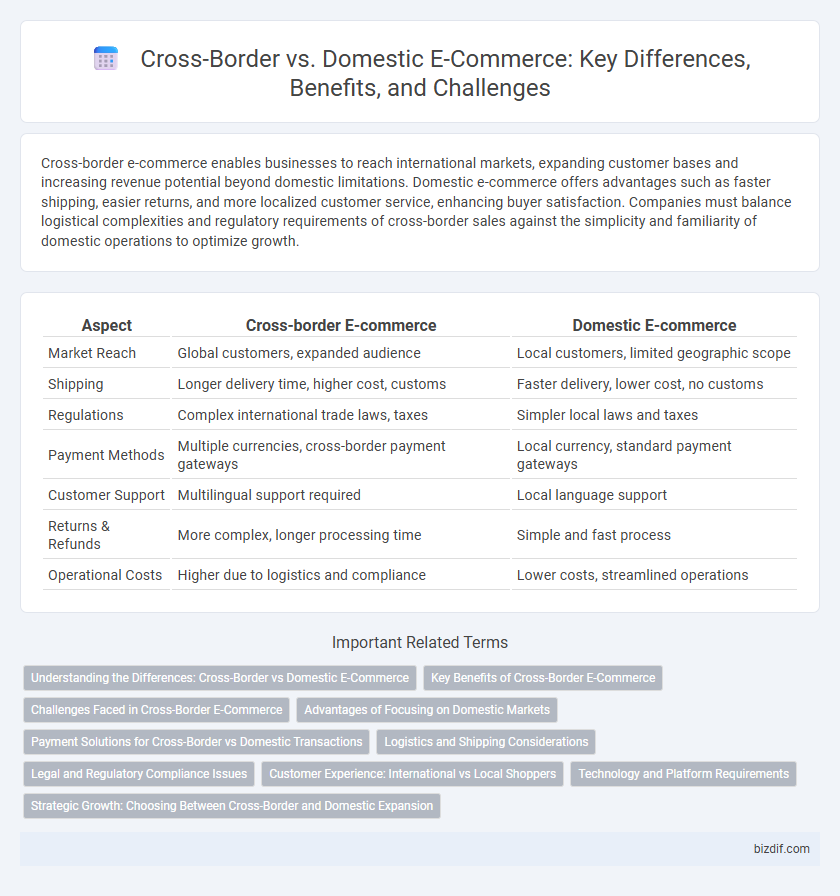Cross-border e-commerce enables businesses to reach international markets, expanding customer bases and increasing revenue potential beyond domestic limitations. Domestic e-commerce offers advantages such as faster shipping, easier returns, and more localized customer service, enhancing buyer satisfaction. Companies must balance logistical complexities and regulatory requirements of cross-border sales against the simplicity and familiarity of domestic operations to optimize growth.
Table of Comparison
| Aspect | Cross-border E-commerce | Domestic E-commerce |
|---|---|---|
| Market Reach | Global customers, expanded audience | Local customers, limited geographic scope |
| Shipping | Longer delivery time, higher cost, customs | Faster delivery, lower cost, no customs |
| Regulations | Complex international trade laws, taxes | Simpler local laws and taxes |
| Payment Methods | Multiple currencies, cross-border payment gateways | Local currency, standard payment gateways |
| Customer Support | Multilingual support required | Local language support |
| Returns & Refunds | More complex, longer processing time | Simple and fast process |
| Operational Costs | Higher due to logistics and compliance | Lower costs, streamlined operations |
Understanding the Differences: Cross-Border vs Domestic E-Commerce
Cross-border e-commerce involves selling products internationally, requiring businesses to navigate complex customs regulations, currency conversions, and international shipping logistics. Domestic e-commerce focuses on local markets with faster delivery times and fewer regulatory hurdles, leading to enhanced customer satisfaction within the country. Understanding these differences helps optimize strategies for payment processing, marketing, and compliance to boost overall sales performance.
Key Benefits of Cross-Border E-Commerce
Cross-border e-commerce expands market reach by enabling businesses to access a global customer base, increasing sales potential beyond domestic limitations. It offers opportunities for diversification, reducing dependence on local market fluctuations, and enhancing brand awareness internationally. Advanced logistics and payment solutions streamline international transactions, improving customer experience and operational efficiency.
Challenges Faced in Cross-Border E-Commerce
Cross-border e-commerce faces significant challenges such as complex customs regulations, varying tax policies, and language barriers, which increase operational costs and delivery times. Payment processing difficulties arise from currency conversion and fraud prevention measures, complicating transaction security and trust between buyers and sellers. Logistics also present hurdles in international shipping, including higher shipping fees, longer transit times, and issues with tracking and returns compared to domestic e-commerce.
Advantages of Focusing on Domestic Markets
Focusing on domestic e-commerce markets offers advantages such as simplified logistics, reduced shipping costs, and fewer regulatory hurdles compared to cross-border trade. Domestic markets provide faster delivery times and enhanced customer service opportunities due to proximity, leading to improved customer satisfaction and loyalty. Businesses benefit from clearer cultural understanding and easier market adaptation, driving more effective marketing strategies and sales growth.
Payment Solutions for Cross-Border vs Domestic Transactions
Cross-border payment solutions require robust multi-currency support, advanced fraud detection, and compliance with international regulations to ensure secure and seamless transactions. Domestic payment systems prioritize speed, lower transaction fees, and integration with local banks and payment gateways for efficient processing. Leveraging tailored payment solutions enhances customer trust and boosts conversion rates across both cross-border and domestic e-commerce channels.
Logistics and Shipping Considerations
Cross-border e-commerce logistics demand compliance with international customs regulations, increased shipping costs, and extended delivery times compared to domestic shipping. Efficient management of duties, tariffs, and varying carrier partnerships is critical to minimize delays and ensure seamless cross-border delivery. In contrast, domestic shipping offers streamlined operations with predictable transit times, lower shipping rates, and simplified return processes, enhancing customer satisfaction and reducing overall logistics complexity.
Legal and Regulatory Compliance Issues
Cross-border e-commerce presents complex legal and regulatory compliance challenges, including customs duties, import/export restrictions, and adherence to international trade agreements. Domestic e-commerce typically faces more streamlined regulations focused on local taxation, consumer protection laws, and data privacy requirements. Businesses must navigate differences in product standards, labeling laws, and intellectual property rights to ensure lawful cross-border transactions and minimize risks of penalties.
Customer Experience: International vs Local Shoppers
Cross-border e-commerce often delivers a diverse product range and competitive pricing, attracting international shoppers who value global variety and exclusive items. Domestic e-commerce focuses on faster shipping, localized customer service, and seamless returns, enhancing convenience and trust for local buyers. Personalized experiences through language support, payment options, and customer service tailored to the shopper's region significantly improve satisfaction in both international and domestic markets.
Technology and Platform Requirements
Cross-border e-commerce demands advanced technology integration for seamless currency conversion, multi-language support, and compliance with international regulations, contrasting with domestic platforms that prioritize local payment gateways and regional logistics optimization. Platforms must incorporate scalable cloud infrastructure, AI-driven customer service, and robust cybersecurity to handle global traffic and data privacy laws such as GDPR. Leveraging APIs for real-time customs clearance and cross-border shipping tracking enhances operational efficiency, setting cross-border platforms apart from their domestic counterparts.
Strategic Growth: Choosing Between Cross-Border and Domestic Expansion
Cross-border expansion offers access to larger, diverse markets with higher growth potential, leveraging global consumer demand and broader product reach. Domestic growth provides easier regulatory compliance, localized marketing strategies, and stronger brand loyalty within familiar consumer behavior patterns. Businesses must evaluate infrastructure capabilities, market saturation, and long-term scalability to determine whether cross-border or domestic expansion aligns better with their strategic growth objectives.
Cross-border vs Domestic Infographic

 bizdif.com
bizdif.com